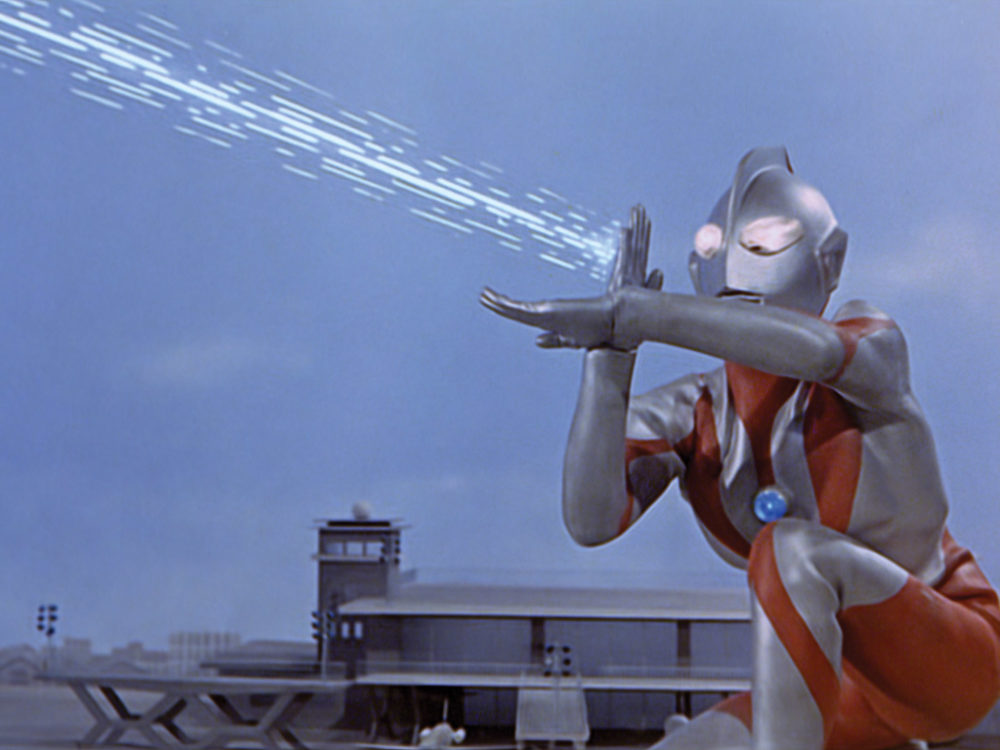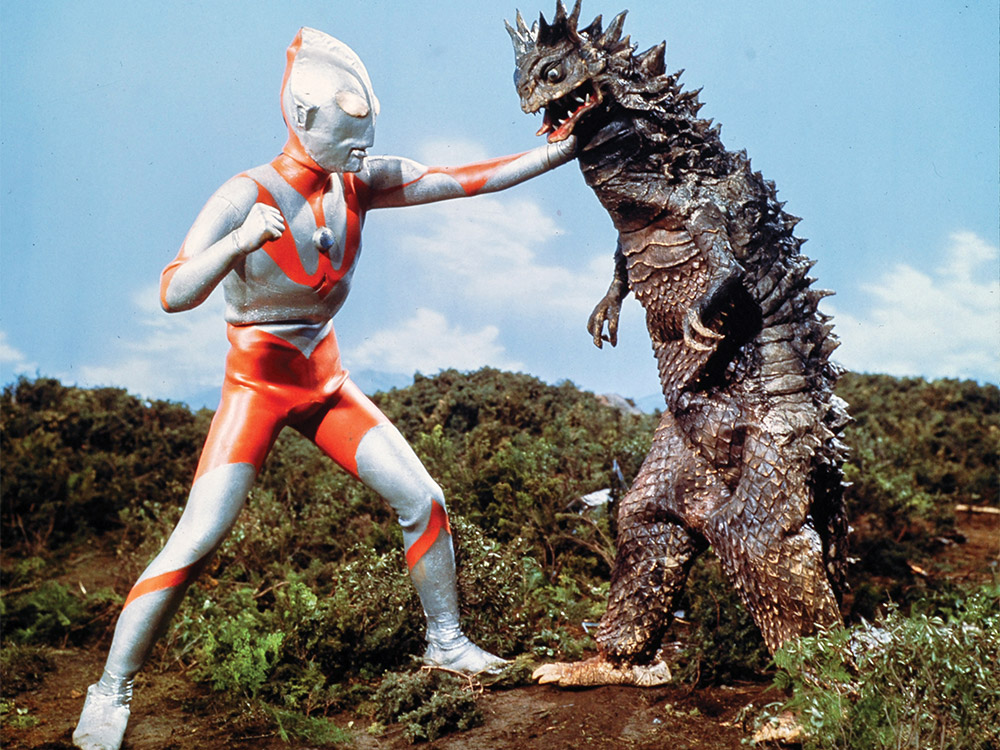Before we had Transformers, Power Rangers, and Voltron, we had one supersized hero: Ultraman. Once a cult, live-action TV series in Japan in the early ‘70s and ‘80s, Ultraman soared to new heights once it began broadcasting in the U.S., gaining an impressive fan following both in America and abroad.
After a tense litigation over trademarks ended its initial U.S. distribution, the Japanese property is set to make its triumphant return to the global stage this spring, following a verdict set in Ultraman’s favor. Still in the early phases of developing how the franchise will return stateside, both the production and licensing teams have rallied the troops to recreate the magic that Americans saw decades ago with new and classic programs.
Remembering a Classic
First appearing in Japan in 1966, Ultraman enthralled viewers with the concept of a human growing into a supersized cosmic being who could defeat iconic monsters known as kaiju. Produced by Tsuburaya Productions, the show grew in popularity across several Asian countries. By the late ‘60s, the classic version of Ultraman arrived in the U.S. in syndication.
“It was a completely new concept. A gigantic hero didn’t really exist before,” says Kei Minamitani, general manager at Tsuburaya Productions. “It wasn’t just about the superhero killing bad enemies, but we have 3,000 different types of kaiju in our archives now, and the thing is that each kaiju has their own story. So I believe that is one of the reasons why, at the time, people were excited about the series, and it is still going on.”
When the series was first syndicated in America, Ultraman stood out with its unique character stylizations.
“I think there’s an aspect [that] it’s not Western and it definitely has a different point of view in terms of how [fans] view heroes,” says artist and toy collector Mark Nagata, in regard to Ultraman. “I think most Western types of heroes were very cut and dry. It’s a hero, so he’s going to save the day, and things kind of end on a happy note … .”
Piquing fans’ interest with unique styling, action-packed battles, and cosmic superpowers, the show soared in popularity. While the Western Hemisphere was left with an Ultraman void during the creators’ legal battle, the hero flourished in Asia as Tsuburaya continued to produce new series. Now, it’s time to reintroduce Ultraman to a new generation of American fans.

Getting Reacquainted
Tsuburaya and its U.S. licensing partner, The Licensing Group, announced the return of Ultraman at last year’s Licensing Expo, exciting former fans and potential licensees.
“We were sitting down and many people just came up to us, saw Ultraman on the board and would stop by and say ‘I know this character; what are you going to do with this?’” Minamitani says. “It was really surprising to see so many people who knew the character and were looking forward to it.”
Many of the show’s original U.S. fans found the hero through the series’ daily syndication between 1966 and 1981. Danny Simon, founder of the Licensing Group, explains that many former Generation X viewers remain fans of the property today, anticipating its return and looking forward to passing down something they enjoyed to their own kids.
To kick off the process of bringing the iconic franchise back to North America, Minamitani says the first phase will bring the classic series back into the mainstream market and reintroduce people to the beloved hero and his kaiju opponents. Tsuburaya plans to focus on the original live-action series, in addition to a new sequel on Netflix that was released in April, which features advanced animation styles and the son of the original hero taking on the iconic moniker to save Earth from a new alien threat. In addition to bringing original programs to the Western market, potential new live-action films and series are in development to create new realms for the iconic hero.
The creators also aim to focus on new licensing opportunities and merchandising as a way to further engage the passionate fan base that has been clamoring for the hero’s global comeback.
“As we’re just starting, we know that it’s a challenge as there are lots of different heroes and IPs everywhere in the global market now. And we believe it’s a big challenge, but what we believe is that we have a different virtue to characters than the U.S. makes,” Minamitani says. “What we’re trying to achieve here is to introduce not a new type, but a different type of character into the market, which is a challenge, but I think it’s feasible. But we’ve only just started, so we’ll see where it goes.”
Soaring to Shelves
Although they’ve only just started, fan excitement for new merch promises an optimistic future for the brand. A collection of Ultraman Funko Pop! figures sold out within the first week of their launch, proving fans’ appetite for the nostalgic series, which bodes well for expansions.
“We know that there’s an audience that remembers Ultraman, and we want to play to that audience initially in re-establishing the character,” Simon says. “We’re actively engaging licensees now, already signed up a number of companies in various categories, and are in discussion with a number more.”
New products will pay tribute to the iconic series and its characters, bringing a sense of nostalgia to new merchandise. New licensees will see the creation of comic books, collectibles, apparel, gifts, novelty, and toys, Simon explains.
While there is no confirmed media program in place yet for the return of the classic series or any new live-action films, the Licensing Group and Tsuburaya are looking for dedicated companies to develop an ongoing partnership as the franchise develops.
“A couple of us grew up in the ‘80s and [Ultraman’s] the kind of stuff we grew up with and were interested in. Now that we’re in a position where we can really capture our youth and create cool products that we didn’t have when we were young, we’re going back and chasing after a lot of these vintage categories,” says Eric Phan, chief marketing officer at apparel company Bait, one of the merchandising partners currently on board.
While the franchise team is in the process of signing on new licensees to expand Ultraman’s reach, several existing partners are working to craft unique apparel, accessories, and collectibles based on fans’ nostalgia for the iconic characters and its images.
Due to Ultraman’s U.S. absence, there’s been a lack of new products in the market. So, original fans will likely be excited to get their hands on new merch — currently in development — that they could have only wished existed back in the day.
“I think the fan reaction is going to be great,” says Will Thompson, president of licensing at apparel manufacturer Changes. “There’s been a real drought of product in the U.S., and people have not been able to get ahold of a cool Ultraman T-shirt for a long time, so I think we have a real audience and a real build-up out there of interest, and I think we’re going to do really well with it.”
For Bait, Phan explains how many of the original American audience members have a more expendable income now and can pay more for rare, exclusive, higher-end products. Other partners, such as Changes or collectible pin company FanSets, also see the value of the property’s core fans and plan to showcase the iconic Ultraman imagery as inspiration for new merchandise.
FanSets is known for its deep dives into DC characters on collectible pins and is currently expanding into other licenses. Ultraman seemed to be the perfect partner for the collectibles manufacturer, considering the diverse characters in the franchise.
A Bigger Ultraman
Ultraman still has a long way to go, but before long, fans will be reveling in a new series and merchandise meant to reacquaint them with the supersized hero and stable of intricate kaiju. “Our mission is, at this stage, to expand the franchise for the next 50 years, try to expand it and try to make it even better so it lasts for another 50 years,” Minamitani says. As Ultraman continues to do well in the Asian market, Minamitani hopes Tsuburaya and its partners can replicate its success in the U.S.
“The goal would be to be able to be continuously producing feature films [and] series in a continuous manner, not just to make one feature film, but to keep on creating the franchise, so that’s what we have to try to control and have to understand and be careful about,” Minamitani says. “We’re just very excited about getting back to the U.S. [It] is such an important market for this entertainment [property] and characters. It’s a major challenge; [there are] lots of IPs in the market, but we’ll see if we can penetrate and if we can reach the mass market. … [We are] very excited though.”
This article was originally published in the Pop Insider’s Spring 2019 Issue No. 3, click here to read more!
Photo: Tsuburaya Productions/ The Licensing Group

